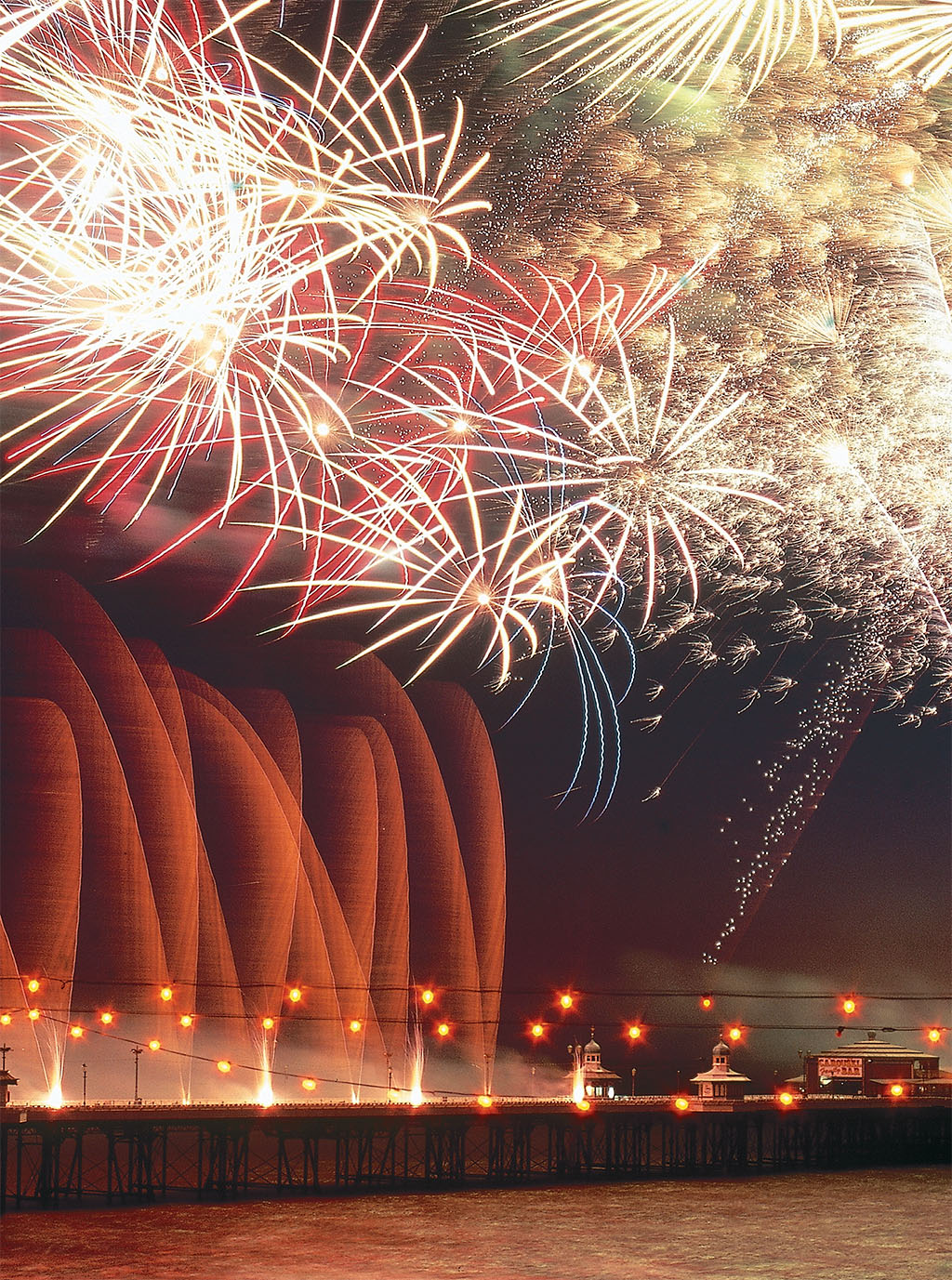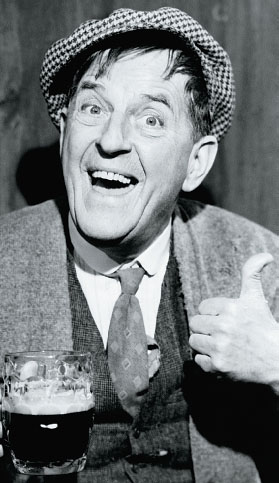
The world’s first and greatest seaside resort for the working class glows with its annual festival
[caption id="IlluminatingBlackpool_Feature" align="aligncenter" width="1024"]

JIM HARGAN
JUST AS KARL MARX PUBLISHED his Law of the Increasing Misery of the Working Classes in the mid-19th century, the English Midlands working classes started taking vacations. This was completely new and unexpected; never in the history of mankind did ordinary working people have enough money to knock off for a week and go somewhere else. Because this was an absolutely unique turn in history, there wasn’t any place for them to go—so they had to create a place, a pleasure resort just for themselves. That place was Blackpool.
Marx completely missed this proletarian revolution, but you don’t have to. Blackpool remains a vital, energetic resort, bursting with people who work hard for a living and play hard on a holiday—a toff-free zone. Everyone in Britain sees Blackpool as a city that lives wholly in the present. That’s accurate. Nevertheless it’s a historic city, as important and as interesting as any, filled with remarkable structures from every period since factory folk first had spare change rattling in their pockets. And chief among its historic attractions is its annual festival, the Illuminations.
The yearly extravaganza started quite accidentally. Back in 1913, Blackpool, electrified since 1879, decided to celebrate a royal visitation with something that would distinguish it from other places—a new electrical spectacle. Despite the fact that the royal visit occurred in the cold, wet weather of September, an estimated 100,000 people flooded into Blackpool in a single week for the event, jamming the hotels and pubs. The revolution, it seems, had hit a new level; the proletariat now had the means to travel whenever they wanted to. All they needed was a reason, and the Blackpool merchants decided to give them one. They’ve held the Illuminations every September and October since.
To understand the Illuminations, you need to understand Blackpool, a beachside city on the Irish Sea, about 50 miles northwest of Manchester. Like most beach resorts, it is long, skinny and completely built up—a strip about three miles long by a half-mile wide, with suburbs stringing another five miles north and south. There is a thickly built Victorian center, noted for its beautifully elaborate theaters, where performances of legitimate plays alternate with old-fashioned music hall bills. From this, the Golden Mile stretches southward, with a 520-foot-tall Eiffel-ish tower (built in 1894) and three long piers covered with amusement rides and more theaters. The beach itself is long gone; since the 1860s, high tide has broken against a great sea wall, and bathers have to wait for low tide to enjoy the sand.
[caption id="IlluminatingBlackpool_img1" align="aligncenter" width="1024"]

JIM HARGAN
‘LIGHTS STRETCH ALONG THE BEACHSIDE BOULEVARD’
THE TRAMCARS UNIFY IT ALL. Created in 1885, Blackpool’s 11 miles of tramline is the oldest surviving street rail system in Great Britain. Blackpool couldn’t exist without it. Running between the seawall and the highway, it glides silently past the stopped traffic at speeds up to 30 miles per hour. A cheap all-day pass allows visitors to hop on, go quickly to a destination a mile or two away, then hop off. It’s the best place to meet people, as nearly everyone will jump on or off at one time or another. This includes such characters as an extremely elderly woman, her sleeve rolled up to reveal a tattoo spanning multiple wrinkles, so recent it glistens, her face glowing with joy: “I thought I’d better do it all now, dear, while I still had the chance.” The upper platforms of Blackpool’s omnibuses give wide views in all directions, a wonderful amusement ride in itself.
The bustling resort’s entire seafront is jammed chockablock with buildings—attractions of all sorts along the Golden Mile, then nonstop terrace hotels for another two miles. Here stretch literally hundreds of small bed and breakfast hotels in rows of attached terraces, in all grades of quality, climaxing at the modern Big Blue Hotel, with some of the town’s best rooms and best food. Although large, the Big Blue is dwarfed by the gigantic steel roller coaster that looms above it. Part of the Pleasure Beach complex of amusement rides, “The Big One” is one of the largest steel roller coasters in the world, an impressive symbol of Blackpool’s stubborn pursuit of the next generation of working class tourists.
THE ILLUMINATIONS are central to that pursuit. At once traditional and modern, historic and continuously renewed, the Illuminations epitomize Blackpool. The light displays start at the southern end of the town, at Pleasure Beach, by the Big Blue and the roller coaster. From there they stretch northward along the beachside boulevard, an unbroken string of bright lights, each block with its own theme. These form a very carefully orchestrated series to the town center, then slightly beyond to a place where relic sand dunes provide a park between the street and the beach. Here the Illuminations reach their climax with a set of tableaux, with new ones each year replacing some 20-year-old favorites. Lights go on and off in sequence, creating illusions of animation, while mannequins move about; a motorcyclist does stunt jumps, a pirate makes a foofy aristocrat walk the plank, and (a crowd favorite) a giant mummy inflates explosively from a sarcophagus. You can drive slowly past it all, or you can take a tram (illuminated, of course), which gives a full view of the entire processional.
The Illuminations are so elaborate that it takes five months to set them up, and two months to break them down again. “If we didn’t take them down,” says Illuminations manager Richard Ryan, “they wouldn’t be as special.” The backs of the tableaux, facing the rough autumn seas, are a mess of wiring that require constant attention, and crews rush about fixing problems throughout the night. Borough employees such as Ryan take the Illuminations very seriously. “I’ve always done Illuminations, started when I was 7,” says the electrical engineer. “I did one with lights pegged on a board.”
‘THE SEAFRONT IS JAMMED WITH ATTRACTIONS ALONG THE GOLDEN MILE’
WHILE MANY COME TO THE ILLUMINATIONS just to see the lights, there’s a lot more to it. A major celebrity starts the festivities with a grand Switch-On ceremony; in 2007 it was the current star of Doctor Who, David Tennant. Art exhibits and a series of performances occur on weekends, with 2007’s offerings themed around the Victorian entertainments of early Blackpool. Best of all is September’s huge weekly International Fireworks Competition, with one finalist from each of four countries presenting a performance from the North Pier. Trust me, this is in a whole ’nuther class from your average July Fourth display.
The proletarian revolution moves on, and Blackpool moves with it.
Nowadays the working classes of Britain are so prosperous that they think nothing of popping off to Spain or Greece for a week on a beach that is warm and sunny and exists even at high tide. Quite a problem for old Blackpool. But honestly, can Spain offer roller coasters on piers that extend a quarter-mile into the sea, fast-paced music-and-comedy shows in grand old Victorian theaters, plus miles of seaside attractions? Can Greece offer anything like Doctor Who lighting the Illuminations? Quite so. Other places may be warmer, but Blackpool is just pure-D fun. Blackpool, built by and for the working people of Britain, knows its audience and is here to stay.
[caption id="IlluminatingBlackpool_img2" align="aligncenter" width="1024"]

JIM HARGAN
Albert and the Lion By Marriott Edgar
[caption id="IlluminatingBlackpool_img3" align="alignright" width="279"]

© PICTORIALPRESS LTD./ALAMY
Typifying the wit of Blackpool and northern England, here’s a piece of classic music hall monologue, written in 1932 for the inimitable Stanley Holloway.
There’s a famous seaside place called Blackpool,
That’s noted for fresh air and fun,
And Mr. and Mrs. Ramsbottom
Went there with young Albert, their son.
A grand little lad was young Albert,
All dressed in his best; quite a swell
With a stick with an ’orse’s ’ead ’andle,
The finest that Woolworth could sell.
They didn’t think much to the Ocean:
The waves, they was fiddlin’ and small,
There was no wrecks and nobody drownded,
Fact, nothing to laugh at at all.
So, seeking for further amusement,
They paid and went into the Zoo,
Where they’d Lions and Tigers and Camels,
And old ale and sandwiches, too.
There were one great big Lion called Wallace;
His nose were all covered with scars—
He lay in a somnolent posture,
With the side of his face on the bars.
Now Albert had heard about Lions,
How they was ferocious and wild—
To see Wallace lying so peaceful,
Well, it didn’t seem right to the child.
So straightway the brave little feller,
Not showing a morsel of fear,
Took his stick with its ’orse’s ’ead ’andle And pushed it in Wallace’s ear.
You could see that the Lion didn’t like it,
For giving a kind of a roll,
He pulled Albert inside the cage with ’im,
And swallowed the little lad ’ole.





Comments